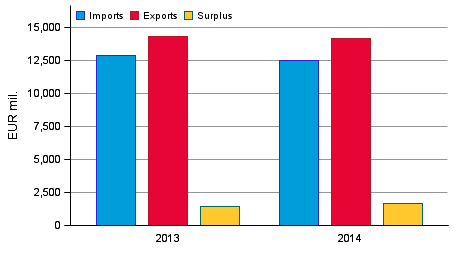This set of statistics has been discontinued.
Statistical data on this topic are published in connection with another set of statistics.
Data published after 5 April 2022 can be found on the renewed website.
Published: 27 May 2015
Surplus in international trade in services from computer and information services
According to Statistics Finland’s preliminary data, the surplus in international trade in services grew by over ten per cent in 2014 compared with the previous year. A majority of the growth is explained by exports of computer software that grew by more than EUR one billion. Both computer software and other computer and information services are good EUR two billion in surplus, which resulted in a total surplus of EUR four billion in computer and information services.
Service imports, exports and surplus in 2013 to 2014, EUR million

The exports and imports of services decreased slightly in 2014. Services were exported to the value of EUR 14.2 billion, while service imports amounted to EUR 12.5 billion. The surplus in international trade in services was EUR 1.6 billion.The value of net sales of goods processed abroad and of merchanting nearly halved in 2014 compared with 2013. The value from this item was only EUR 1.6 billion in 2014 while it had been EUR 2.8 billion in 2013.
Sales margin from goods manufactured abroad in 2013 to 2014, EUR million
| Item | 2013 | 2014* |
| Net sales of goods processed abroad and of merchanting | 2 810 | 1 637 |
The structures of service exports and imports differ
Nearly one-half of the value of service exports is generated from computer and information services. In addition to computer and information services, other considerable items in service exports in 2014 were technical, trade-related and other business services, user licences of results from R&D activity, as well as construction abroad and project deliveries abroad. Together, these items cover nearly 80 per cent of service exports. Of these, user licences of results from R&D activity, as well as construction abroad and project deliveries abroad decreased by one-third compared with the previous year.
In imports, no similar exceptionally large individual item can be pointed out. In service imports, important items were research and development services, advertising, market research and public opinion polling, trade-related services, and services that cannot be placed under other items in the used classification. The above-mentioned items cover around one-half of service imports. Imports of trade-related services grew clearly compared with the previous year, amounting to nearly EUR one billion in 2014. Over the same period, spending on royalties and licence fees n.i.e. nearly halved, however. The biggest deficit in services is generated in research and development services and in business and management consulting services. These items were both around EUR 1.5 billion in deficit.
Main trade partners in EU countries
Examined by region, the main trade partners have remained unchanged from 2013. Countries in the European Union cover 67 per cent of imports and 57 per cent of exports. The most significant change in country-specific figures was a decrease in service imports from Ireland to nearly one-half from 2013.
Of Asian countries, Japan surpassed China as the main trade partner in service exports with a share of 20 per cent in Asian exports. In terms of service imports, China remained the main trade partner with a share of good 40 per cent of total Asian imports. In terms of America, the share of the United States was most important both in exports and imports in 2014 as well.
Division by service items differs by region
The regional division of income received and expenses paid on royalties and licence fees n.i.e. differ from one another. Payments related to royalties and licences are mainly directed at countries within the European Union. The income from royalties and licences comes from EU countries, Asia and America, each of which represents around one-third of the income.
The regional division of construction services and project deliveries is similar. Enterprises in European Union countries produce construction services and make project deliveries to Finland, while Finnish enterprises' construction services and project deliveries are directed throughout the world. The share of Asian countries in the exports of construction services and project deliveries decreased compared with the previous year while the share of European Union countries increased.
The share of other business services in service imports is three-quarters in Asian and American countries. In Europe, this share is only one-half. Correspondingly, the share of royalties and licence fees n.i.e. in service exports is higher in Asia and America than in Europe, where the share of other business services is more significant.
Source: Foreign trade in services 2014, Statistics Finland
Inquiries: Pauliina Peltonen 029 551 2585, Risto Sippola 029 551 3383, globalisaatio.tilastot@stat.fi
Director in charge: Hannele Orjala
Publication in pdf-format (209.0 kB)
- Tables
-
Tables in databases
Pick the data you need into tables, view the data as graphs, or download the data for your use.
Appendix tables
Updated 27.5.2015
Statistics:
International trade in services [e-publication].
ISSN=1798-3525. 2014. Helsinki: Statistics Finland [referred: 19.4.2025].
Access method: http://stat.fi/til/pul/2014/pul_2014_2015-05-27_tie_001_en.html

